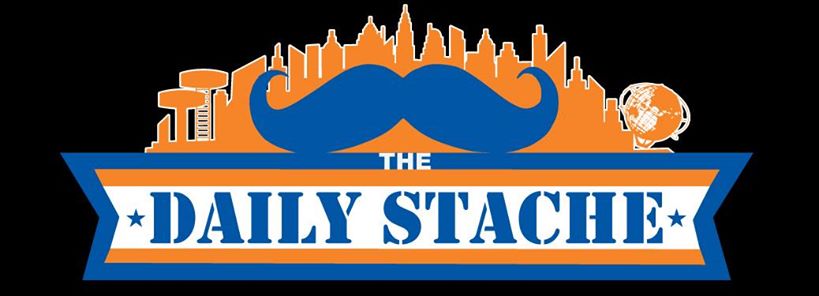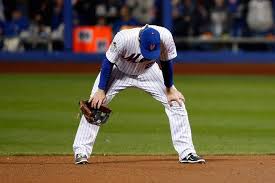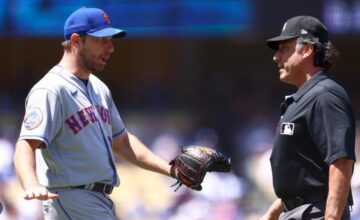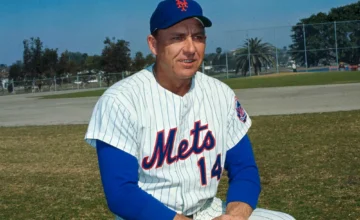During his seven seasons with the Mets, Daniel Murphy came to be a fan favorite with his clutch hitting and winning personality. His post season home run spree from last year broke a record and will always be the stuff of legend, surpassing the amazing post season performances of Met greats Donn Clendenon and Edgardo Alfonzo. But when it came to defense, well, let’s just say Daniel was a heck of a hitter. With Murph returning to Citi Field this week with the hated Washington Nationals, here is a list of the worst defensive player at each position in Mets history in Murphy’s tin gloved honor. And yes, this list is subjective, so feel free to add your list in the comments.
- Catcher: Mackey Sasser. The Mets have had some defensively challenged catchers over the years, but none more so that Mackey the hacker. He developed a throwing problem but it only involved the simple task of throwing the ball back to the pitcher. For some inexplicable reason, Mackey would make two pump fakes before making the simple throw. This is a huge problem since the catcher will have to make that toss at least 100 times each game. Fans picked up on it and clapped along to Mackey’s pumps. Opposing baserunners picked up on it too, and stole a few cheap bases off of his throwing impediment. Strangely enough, Mackey had no such problem making the throw to second on a stolen base attempt.
- First Base: Marv Throneberry. Marvelous Marv came to the Mets in 1962 for their first player, catcher Hobie Landrith, and he had a reputation as a good defensive first baseman, having been used as a defensive replacement by the Yankees in the late 50’s. Marv had the unenviable task of filling in for perennial Gold Glover Gil Hodges when he was out with a number of injuries. And in that 1962 season, Marvelous Marv made the absolutely mind boggling number of 17 errors at first base in only 97 games for the unfathomable fielding percentage of .981! His defense (or lack thereof) became the stuff of legend. But don’t cry for Marv, Argentina, as he parlayed this ignominy into a series of successful beer commercials in retirement.
- Second Base: Daniel Murphy. This wasn’t too difficult. The only other player under consideration was Luis “Pop Up” Castillo, but he wasn’t as awful as the Murph. Daniel could make a difficult play look routine and then a routine play look difficult. His drop kick from Carlos Torres play was probably the play-of-the-year for last year’s Mets, but despite his heroics with the bat and on that play, two errors by Murph cost the Mets in games 4 and 5 of last season’s World Series. Throwing to the wrong base, kicking the ball, letting it scoot under his glove or failing to cover second were all mental mistakes by Murphy. In fairness to Daniel, he was actually signed as a third baseman and moved to second to get his bat into the lineup after failing at left field and first base.
- Short Stop: Kaz Matsui. When the Mets signed Kaz Matsui before the 2004 season, many thought it was a publicity stunt to try to match their cross town rivals who had just signed the more talented and better known Hideki Matsui aka Godzilla. Nevertheless, Kaz came to the Mets with a reputation as a clutch hitter and a defensive whiz. He proved to be neither. He lacked the range to play short in the Majors and he had a very weak arm. Still, the Mets awarded their big free agent signing the short stop job, moving phenom Jose Reyes to second where Reyes promptly got injured trying to play an unfamiliar position. Meanwhile Kaz Ka-blooie (as my friends called him) made 23 errors in 110 games for the 2004 Mets while having a very awful range factor of 4.52. Mercifully, the Mets moved him to second and Reyes to short before the 2005 season. Still, I think Kaz is the easy choice here.
- Third Base: Richie Hebner. The Mets made a revolving door out of the not-so-hot corner before finally getting some longevity out of HoJo, Ventura and the Captain. But probably the most defensively challenged third baseman in Mets history was Richie Hebner. The Mets had been trying to get the Gravedigger for years, thinking the veteran would provide leadership, lefthanded power and solid defense at third. After getting him for righty starter Nino Espinosa, the Mets found that he provided none of this. Aside from moping and giving Met fans the finger on his last day as a Met player, Hebner dug a defensive grave at third for the team’s pitchers. He made 22 errors in his lone season for the Mets, while only turning 26 double plays. He had a deadly .940 fielding percentage and a morbid 2.57 range factor in 134 rigor mortis games at the hot corner. Considering he was up against such defensively challenged players as Howard Johnson, Dave Magadan, Frank J. Thomas, Dave Kingman and Charley Smith, you could say that the Gravedigger beat out some stiff competition.
- Left Field: Dave Kingman. With Kingman in left, fly balls were not just a job, they were an adventure. If there ever was a player for whom the designated hitter was invented, it was David Arthur Kingman. Kong may have been Sky King at the plate, but the skies were not friendly to Kong when he played left at Shea. He made 6 errors in left in ’75, 1 more in ’76 and 3 more in ’77 during his first tour of duty with the Mets, before making 7 more in ’81 on his return trip (mercifully, the Mets moved Kong to first full time in ’82 to avoid more mishaps). Not only did his lack of fielding hurt his pitching staff, but it probably cost him a shot at Roger Maris in 1976 when he hurt his thumb diving for a ball on July 19 in a game against the Braves. Kong had 32 homers at the time, but hit only 5 more when he returned in August. That season, he played mostly in right, but that game in left cost Kong and the Mets big time. Based on my own observations, Kingman was the absolute worst defensive player to ever wear a glove and the Mets uniform at the same time on a playing field.
- Center Field: Juan Samuel. This one comes with some bitterness which I will readily admit. Juan Samuel was a speedy, power hitting second baseman for the Philadelphia Phillies. Mets Assistant GM Joe McIlvaine had scouted Samuel in the Dominican Republic and loved his combination of speed and power. The only problem was that Samuel was a defensively challenged second baseman. That didn’t deter McIlvaine. Neither did the fact that the 1989 Mets were already set at second with equally defensively challenged phenom Greg Jefferies and in center with Lenny Dykstra and Mookie Wilson. Seeking to shake up the team, McIlvaine traded Dykstra and Roger McDowell to the division rival Phillies and promptly installed Samuel in center, a position he had just begun learning to play for the division doormat Phillies. This move would create a Trading Places effect, as Dykstra would become a super star for the Phillies and McDowell would settle down their bullpen, while Samuel misplayed practically ever ball hit to him while having an awful time at the plate. Sammy would be traded to the Dodgers after the season, but the damage had been done. The Sammy Experiment would usher in an era in which the Mets went through a succession of center fielders (including Darryl Boston, Keith Miller, Vince Coleman, Howard Johnson, Ryan Thompson and Brett Butler) before signing Lance Johnson before the 1996 season. It would also usher out an era in which the Mets were perennial contenders.
- Right Field: Roger Cedeno. The uncle of Yongervis Solarte (one of my favorite baseball names) looked like he had all the tools to be a good fielder. He was fast and had a decent throwing arm. The only thing he lacked was any real skills or baseball IQ. Hit the cutoff man. What’s a cutoff man? Take a good angle to the ball. What’s an angle? Get a good jump on a ball. What’s a jump? Position yourself well. What’s positioning? While he only made 6 errors in right during his three seasons with the Mets (1999, 2002, 2003), it was all the balls he didn’t catch or misplayed into extra base hits. Cedeno did help us at the plate and on the bases (he set a record of 66 steals in ’99, which was subsequently broken by Jose Reyes), and was the key piece in the trade that brought Mike Hampton to Flushing for the 2000 season. But from my purely subjective standpoint, Cedeno had a stone glove in right, the worst in Mets history.
- Pitcher: Armando Benitez. This is again purely subjective, but Armando was truly awful defensively on the mound. He couldn’t hold runners, didn’t have a pickoff move and was a disaster on bunts. In addition, he seemed to always balk or throw a wild pitch at the wrong time. In Armando’s defense, his problems seem to be common for hard throwing relievers. Jeurys Familia is another closer who will never merit consideration for a Gold Glove (Familia routinely rates a 4 or 5 in Stratomatic Baseball, which denotes a below average or even historically awful defensive range).
Those were my 9 winners of the Murphy’s Law awards. What do you think? Do you agree? Are their other players you’d nominate? Let us know in the Comments section below.





4 Comments